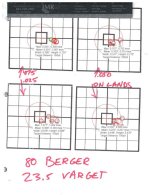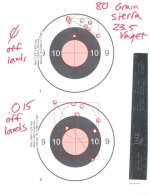I've done some searches and haven't really found a good answer to this question. Maybe I'm just not a good searcher or haven't searched hard enough.
If I find that a particular bullet shoots best out of my gun when seated further off the lands than recommended, is it likely that most bullets will shoot better with more jump than recommended? Not that every bullet is going to shoot best when seated the same distance from the lands, but will they all trend in one direction relative to the norm?
Here's an example. I tested some 85 gr HPFB jacketed bullets with 42 grains of IMR4350 out of my .243, and found that as I increased seating depth from 0.010" of jump to 0.050" my groups steadily decreased from 2.5 MOA to 0.6 MOA. So compared to the common recommendation I've read to start around 0.020" off the lands, it seems this gun likes this bullet to be seated a bit deep.
I'd like to try loading the Barnes 80 gr TTSX in the same gun. Slightly different weight, different bullet construction. Barnes recommends starting at 0.050" off the lands and increasing seating depth in 0.025" increments. Given the jacketed HPFB performance, would it make sense to start at something more like 0.075" or even 0.100" and avoid wasting components and time, or is it possible that this bullet might work better seated shallower than recommended?
I guess the boiled down version of the question is: do specific guns tend to "like" all bullets seated shallow or deep, or will they shoot some bullets better shallower and some deeper?
Thanks for any insight you might have.
If I find that a particular bullet shoots best out of my gun when seated further off the lands than recommended, is it likely that most bullets will shoot better with more jump than recommended? Not that every bullet is going to shoot best when seated the same distance from the lands, but will they all trend in one direction relative to the norm?
Here's an example. I tested some 85 gr HPFB jacketed bullets with 42 grains of IMR4350 out of my .243, and found that as I increased seating depth from 0.010" of jump to 0.050" my groups steadily decreased from 2.5 MOA to 0.6 MOA. So compared to the common recommendation I've read to start around 0.020" off the lands, it seems this gun likes this bullet to be seated a bit deep.
I'd like to try loading the Barnes 80 gr TTSX in the same gun. Slightly different weight, different bullet construction. Barnes recommends starting at 0.050" off the lands and increasing seating depth in 0.025" increments. Given the jacketed HPFB performance, would it make sense to start at something more like 0.075" or even 0.100" and avoid wasting components and time, or is it possible that this bullet might work better seated shallower than recommended?
I guess the boiled down version of the question is: do specific guns tend to "like" all bullets seated shallow or deep, or will they shoot some bullets better shallower and some deeper?
Thanks for any insight you might have.


